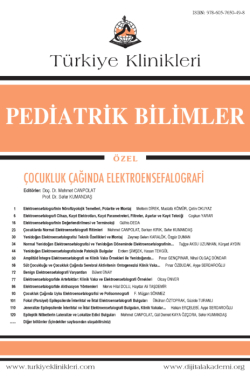Electroencephalography Machine, Recording Electrodes, Recording Parameters, Filters, Settings, and Recording Technique
Coşkun YARARa
aÇocuk Nörolojisi BD, Eskişehir Osmangazi Üniversitesi Tıp Fakültesi, Eskişehir, TÜRKİYE
Yarar C. Elektroensefalografi cihazı, kayıt elektrotları, kayıt parametreleri, filtreler, ayarlar ve kayıt tekniği. Canpolat M, Kumandaş S, editörler. Çocukluk Çağında Elektroensefalografi. 1. Baskı. Ankara: Türkiye Klinikleri; 2019. p.6-15.
ABSTRACT
Although the general rules used in electroencephalography (EEG) recording in adults are valid in children, there are some differences specific to this period. Digital EEGs have often begun to replace analog EEGs, and have provided several advantages, such as data storage and the possibility to reinterpret the data by changing the settings. In the neonates, infants and children have different anatomic and neurophysiological features, there may also be difficulties in compliance to EEG recording. The number of electrodes, montages, settings, recording parameters and recording technique may vary depending on this period. There may be difficulty in provocation tests such as hyperventilaton in children. Children tend to move more than adults during EEG recording. The EEG technician should note the events, who observed during the EEG recording in a timely and complete manner. In order to interpret the EEG in children correctly, it is important to know the clinical characteristics of the child in addition to the technical information about the EEG.
Keywords: Electroencephalography; child; infant, newborn; epilepsy
Kaynak Göster
Referanslar
- Komşuoğlu SŞ, Selekler HM, Alemdar M. EEG çekimi ve teknik bilgiler. Olgu Sunumları ile Klinik EEG Atlası. 1. Baskı. Ankara: Güneş Tıp Kitapevi; 2009. p.7-23.
- Akhan G, Türe HS. [History of electroencephalography]. Turkiye Klinikleri J Neurol-Special Topics. 2017;10(2):105-9.
- Kuratani J, Pearl PL, Sullivan L, Riel-Romero RM, Cheek J, Stecker M, et al. American Clinical Neurophysiology Society Guideline 5: minimum technical standards for pediatric electroencephalography. J Clin Neurophysiol. 2016;33(4):320-3. [Crossref] [PubMed]
- Sinha SR, Sullivan L, Sabau D, San-Juan D, Dombrowski KE, Halford JJ, et al. American Clinical Neurophysiology Society Guideline 1: minimum technical requirements for performing clinical electroencephalography. J Clin Neurophysiol. 2016;33(4):303-7. [Crossref] [PubMed]
- Acharya JN, Hani A, Cheek J, Thirumala P, Tsuchida TN. American Clinical Neurophysiology Society Guideline 2: guidelines for standard electrode position nomenclature. J Clin Neurophysiol. 2016;33(4):308-11. [Crossref] [PubMed]
- Fisch BJ. Fisch ve Spehlmann'dan EEG'ye Giriş. 3. Baskı. Şahiner T, çeviri editörü. İstanbul: Turgut Yayıncılık; 2008. p.3-17.
- Fisch BJ. Fisch ve Spehlmann'dan EEG'ye Giriş. 3. Baskı. Şahiner T, çeviri editörü. İstanbul: Turgut Yayıncılık; 2008. p.35-72.
- Bora İ, Yeni SN. EEG Atlası. 2. Baskı. İstanbul: Nobel Tıp Kitabevleri; 2016. p.17-28.
- Matur Z. Elektroensefalografi cihazı. Bingöl CA, Çelik M, Gürtekin Y, editörler. Klinik Nörofizyoloji Laboratuvarları Uygulama El Kitabı. 1. Baskı. İstanbul: Türkiye Nörofizyoloji EEG-EMG Derneği İstanbul Şubesi; 2006. p.33-4.
- Gökçil Z. Epilepside elektroensefalografi. Bora İ, Yeni SN, Gürses C, editörler. Epilepsi. 1. Baskı. İstanbul: Nobel Tıp Kitabevleri; 2008. p.475-99.
- Misra UK, Kalita J. Clinical Electroencephalography. 1st ed. Noida: Elsevier; 2005. p.12.
- Matur Z. Elektrotlar. Bingöl CA, Çelik M, Gürtekin Y, editörler. Klinik Nörofizyoloji Laboratuvarları Uygulama El Kitabı. 1. Baskı. İstanbul: Türkiye Nörofizyoloji EEG-EMG Derneği İstanbul Şubesi; 2006. p.35-8.
- Bora İ, Yeni SN. EEG Atlası. 2. Baskı. İstanbul: Nobel Tıp Kitabevleri; 2016. p.29-39.
- Abou-Khalil B, Misulis KE. Atlas of EEG & Seizure Semiology. 1st ed. Philadelphia: Butterworth Heinemann, Elsevier; 2006. p.9-28.
- Blume WT, Kaibara M, Holloway GM, Young GB. Blume's Atlas of Pediatric and Adult Electroencephalography. 1st ed. Philadelphia: Lippincott Williams & Wilkins; 2011. p.674-83.
- Blume WT, Kaibara M, Holloway GM, Young GB. Blume's Atlas of Pediatric and Adult Electroencephalography. 1st ed. Philadelphia: Lippincott Williams & Wilkins; 2011. p.2-14.
- Malmivuo P, Malmivuo J, Plonsey R. Bioelectromagnetism. 1st ed. New York: Oxford University Press; 1995. p.364-74.
- Brown V, Haak N, Egel RT. Technical tips: agespecific sleep deprivation guidelines. Am J Electroneurodiagn Technol. 1997;37(3):231-5. [Crossref]
- Mason KP, Lubisch N, Robinson F, Roskos R, Epstein MA. Intramuscular dexmedetomidine: an effective route of sedation preserves background activity for pediatric electroencephalograms. J Pediatr. 2012;161(5):927-32. [Crossref] [PubMed]
- Aksu R, Kumandas S, Akin A, Bicer C, Gümüş H, Güler G, et al. The comparison of the effects of dexmedetomidine and midazolam sedation on electroencephalography in pediatric patients with febrile convulsion. Paediatr Anaesth. 2011;21(4): 373-8. [Crossref] [PubMed]
- Bektas O, Arıca B, Teber S, Yılmaz A, Zeybek H, Kaymak S, et al. Chloral hydrate and/or hydroxyzine for sedation in pediatric EEG recording. Brain Dev. 2014;36(2):130-6. [Crossref] [PubMed]
- Sezer T, Alehan F. Chloral hydrate versus hydroxyzine HCL for sedation prior to pediatric sleep EEG recording. Int J Neurosci. 2013;123(10):719-23. [Crossref] [PubMed]
- Loewy J, Hallan C, Friedman E, Martinez C. Sleep/sedation in children undergoing EEG testing: a comparison of chloral hydrate and music therapy. J Perianesth Nurs. 2005;20(5): 323-32. [Crossref] [PubMed]
- Ashrafi MR, Mohammadi M, Tafarroji J, Shabanian R, Salamati P, Zamani GR. Melatonin versus chloral hydrate for recording sleep EEG. Eur J Paediatr Neurol. 2010;14(3):235-8. [Crossref] [PubMed]
- Ibekwe R, Jeaven L, Wilmshurst JM. The role of melatonin to attain electroencephalograms in children in a sub-Saharan African setting. Seizure. 2017;51:87-94. [Crossref] [PubMed]
- Ashrafi MR, Azizi Malamiri R, Zamani GR, Mohammadi M, Hosseini F. Sleep inducing for EEG recording in children: a comparison between oral midazolam and chloral hydrate. Iran J Child Neurol. 2013;7(1):15-9.
- Fallah R, Alaei A, Akhavan Karbasi S, Shajari A. Chloral hydrate, chloral hydrate--promethazine and chloral hydrate-hydroxyzine efficacy in electroencephalography sedation. Indian J Pediatr. 2014;81(6):541-6. [Crossref] [PubMed]
- Dirani M, Nasreddine W, Melhem J, Arabi M, Beydoun A. Efficacy of the sequential administration of melatonin, hydroxyzine, and chloral hydrate for recording sleep EEGs in children. Clin EEG Neurosci. 2017;48(1):41-7. [Crossref] [PubMed]
- Coté CJ. Sedation for electroencephalograms. Pediatrics. 2001;108(4):1053-4. [Crossref] [PubMed]

